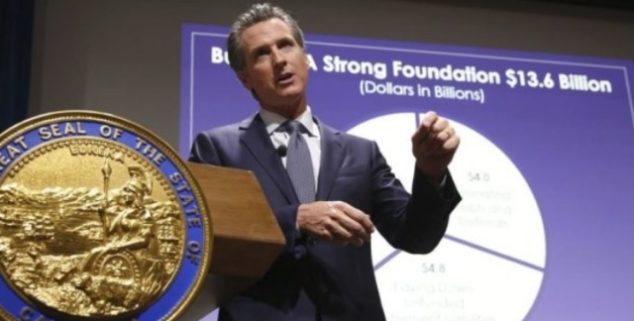News
Cal Channel to end broadcasting after three decades
 Gov. Gavin Newsom presents his state budget for the 2019-2020 fiscal year. Image: Frame capture from Cal Channel broadcast.)
Gov. Gavin Newsom presents his state budget for the 2019-2020 fiscal year. Image: Frame capture from Cal Channel broadcast.)The California Channel, a decades-old public broadcaster that has historically provided on-demand video access to the Legislature, the state Supreme Court and the Capitol community, will cease operations in October.
Supported by the California Cable and Telecommunications Association since 1993, it’s one of the few services that offer one-on-one interviews with all candidates for the state’s elected offices. The Cal Channel has long been viewed as California’s version of C-SPAN, which covers Congress.
(Editor’s Note: The California Channel, a nonfiscal partner of Capitol Weekly, also broadcasts Capitol Weekly’s Politics on Tap TV show and its quarterly policy conferences.)
Since 1998, seven years before Twitter and YouTube, Cal Channel first aired Legislative hearings online and since then, has offered a “front row seat” to state policy.
Cal Channel President John Hancock says the decision to end broadcasting was due in part to the passage of Proposition 54 in 2016, which requires the Legislature to make audio and visual recordings of its legislative proceedings public within 72 hours. The Legislature has its own television and radio services that cover politicians and send stories to their districts.
“The board felt this limited the need for Cal Channel,” Hancock said. The board’s vote occurred earlier this year
Since its beginnings, the Cal Channel has operated much like C-SPAN, offering nonpartisan, unedited coverage beamed directly into offices and homes throughout the state.
In 1989, the non-profit Cal Channel was created by the Center for Governmental Studies in cooperation with the USC Annenberg School of Communications in response to research suggesting the public was dissatisfied with news coverage of state government proceedings.
In 1991, Cal Channel began airing Assembly Floor committee hearings for nearly 2 million homes across the state, quickly growing to 4.6 million five years later.
Since 1998, seven years before Twitter and YouTube, Cal Channel first aired Legislative hearings online and since then, has offered a “front row seat” to state policy.
“The California Channel is a basic journalistic concept – the television camera serving as the eyes and ears of a private California citizen,” Cal Channel’s website says.
“The network’s most important task remains their original one – daily gavel-to-gavel coverage of California legislative debates in the hopes of educating a new generation of civic leaders and voting citizens.”
What’s the future of digital Legislative transparency in California?
“When the California Channel presents a hearing, you don’t get the evening news anchor giving you the network’s spin. You get that quiet camera, focused, unrelenting, critically objective. That’s your eye. And the microphone, that is your ear,” the Cal Channel says.
In 1992, the channel began televising state Senate proceedings and the oral arguments heard before the California Supreme Court on the Master’s Reapportionment Plan. In partnership with C-SPAN in 1997, the Cal Channel transmitted the first ever live broadcast of an “en banc” hearing of a U.S. Circuit Court of Appeals during the Rand v. Rowland and Bates v. Jones court heard arguments.
In 2001, the network received an Emmy Award for the educational video “Checks & Balances: The Three Branches of State Government.”
What’s the future of digital Legislative transparency in California?
Some critics have previously said Proposition 54 has a few loopholes, suggesting that a 72-hour requirement to initial first house votes is not necessary since the bill will not be in its final form.
Columnist Dan Walters, writing then for The Sacramento Bee, noted, “However, not all bills are amended. So under the procedural rules, it would be possible for leaders to write a bill in secret, zip it through the first house without 72 hours of exposure…”
“Technology has radically changed the way society interacts, but government is on the cutting edge of 1973.” — Gavin Newsom
Currently, many websites offer spaces for transparency, like OpenGov, a Silicon Valley-based company that offers cloud-based software to help governments deal with fiscal issues. California State Lobbying Search, a fairly recent endeavor created by coder and former political operative Dave Middleton, is a useful open- source public records tool to help find the connections between bills and lobbying efforts.
Digital Democracy, an online platform to provide greater transparency for the state government, was launched in 2015 in a partnership between then-Lt. Gov. Gavin Newsom and the California Polytechnic State University.
“Technology has radically changed the way society interacts, but government is on the cutting edge of 1973,” Newsom was quoted saying in a State Scoop article.
The platform featured a searchable database of California legislative hearings, with capacity for website visitors to search by keyword, topic, speaker or date. But the project, eventually expanding to Florida, New York and Texas, was suspended in 2018.
Officials at the California Cable and Telecommunications Association were not available for comment.
Want to see more stories like this? Sign up for The Roundup, the free daily newsletter about California politics from the editors of Capitol Weekly. Stay up to date on the news you need to know.
Sign up below, then look for a confirmation email in your inbox.
